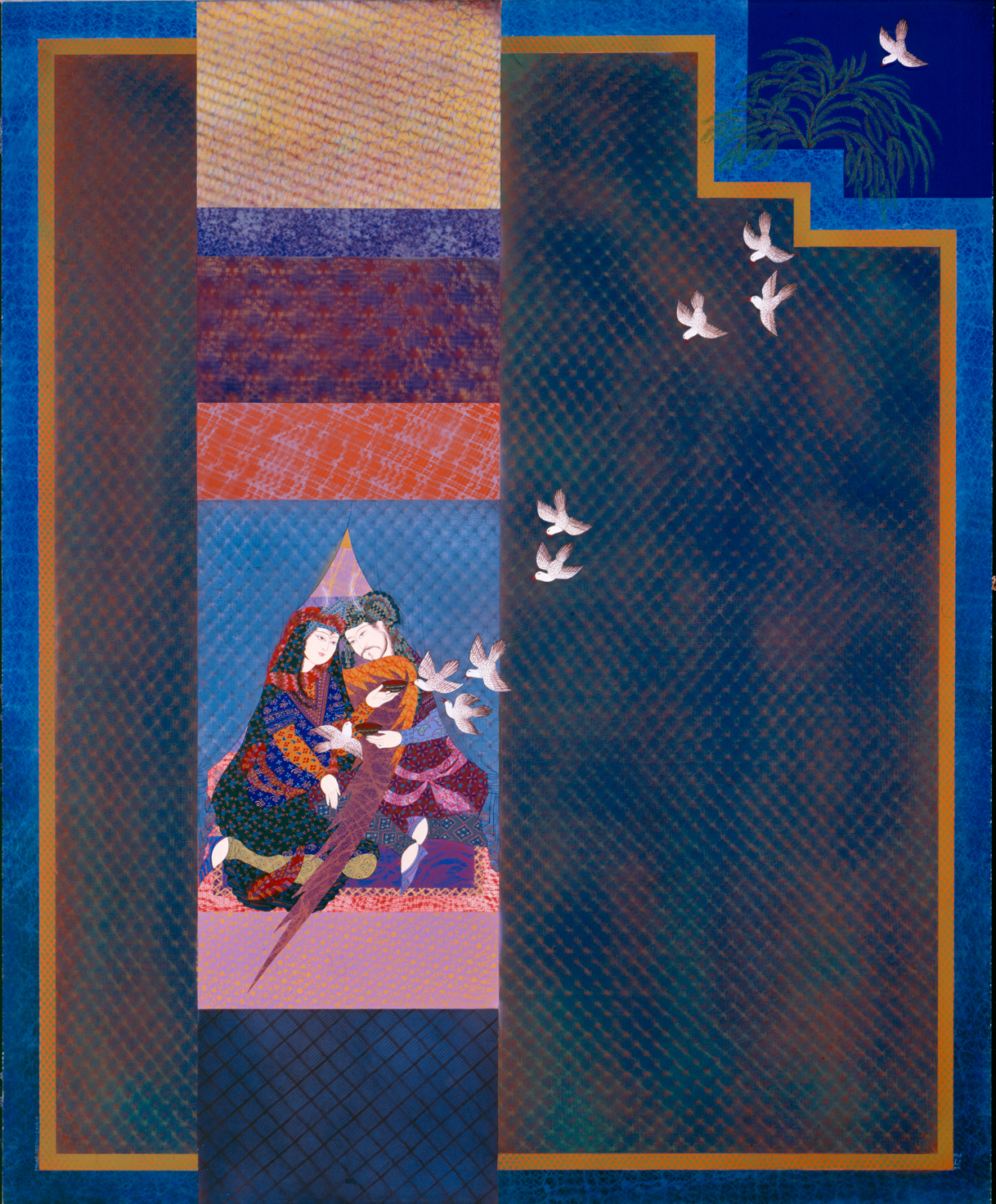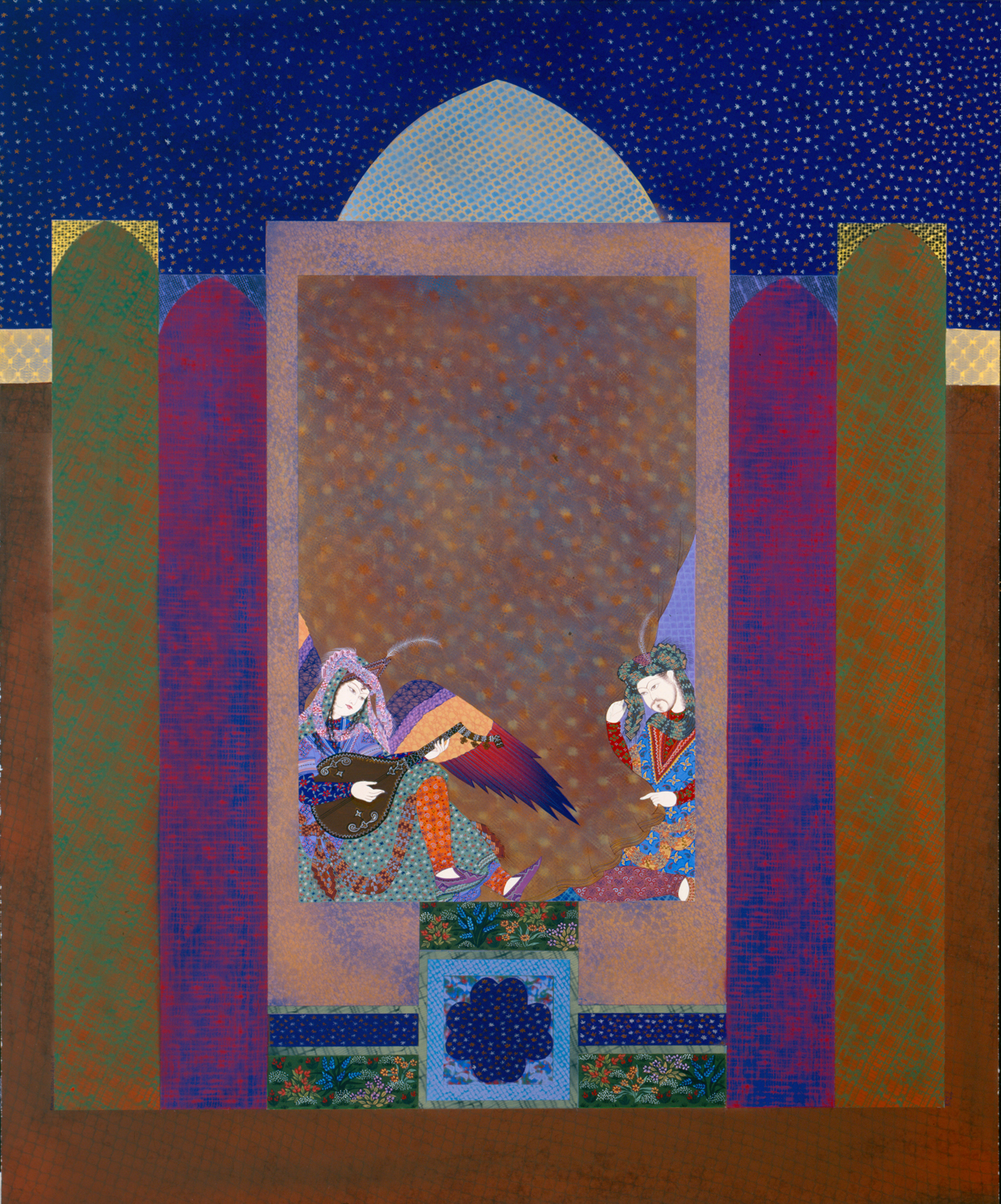

Farah Ossouli, b. 1953, Iran
As a child, Farah Ossouli realised her toy dolls couldn’t act out her make-believe stories as she wished, so she began to create her own characters out of paper and card that she then decorated specifically to manifest her own fairy tales. This process of crafting her own representations of her imagination through collage, pencil and paper spawned her passion for art – a place where she could express her inner dreams in the material world. She continued to make series of new actors with whom she could play, each time throwing the old ones away, all the while developing a deep interest in literature. Fascinated by this mixture of narration and image, Farah found that painting circumscribed both loves and offered her a way to practise both passions simultaneously. Her work is, as a result, a mix of storytelling made up of characters in symbolic landscapes, interlinking with her own understanding and interpretations of life.
In 1971, Farah went to study for a Diploma in Painting at the Girl’s School of Fine Arts in Tehran, before completing a Bachelor of Arts in Graphic Design at the Faculty of Fine Arts at the University of Tehran in 1977. Her bold use of colour and form inflected with symbolism in her oeuvre reflect her academic background rooted in graphics and painting.
Farah’s work can be found in many important collections, including the Los Angeles County Museum of Art and the Metropolitan Museum of Art, both in the USA; the Devi Art Foundation in India; the Koran Museum in Iran; the Tropen Museum in the Netherlands; and the Ludwig Museum in Germany. She is a member of the Society of Iranian Painters and the female Iranian artists group, DENA. Farah was awarded a prize at “Ayeneh dar Ayeneh” in Tehran in 1997 and won the 2000 Renowned Iranian Women Award, the 2002 Iranian Women Artists Prize and the 2002 Prize at the second Biennial of Islamic Contemporary Painting in Tehran. She has sat on several boards and jury panels over the last two decades, including recently acting as head of the jury of the Visual Art Festival at Mellat Gallery in Tehran from 2010–12. Farah was a member of the jury and selection committee of the First International Fajr Festival of Visual Arts at the Tehran Museum of Contemporary Art, Iran in 2009, a curator of the Iranian Art Festival Qanat Al Qasba at Sharjah, UAE in 2008, chairperson of the exhibition Representation of Persian Painting in Iran-Imam Ali Arts Museum in 2007 and a member of the selection committee of the Sixth Biennial of Persian Painting in 2006. She regularly exhibits in both group and solo shows across the globe.
For The unbreakable rope, Farah is exhibiting two works from her Hafiz series, inspired by poetry of the Sufi mystic (circa 1325 to 1389), who wrote paeans to earthly pleasures and disavowed religious hypocrisy. Depicting a pair of lovers embracing under a flock of birds, the first work pictured comes from a Hafiz poem translating to 'The day of travel and night of separation love ended. I predicted this, the star passed, and everything came to an end.' The second shows a couple serenading each other. It illustrates the words 'I am dying with anticipation/dying from eagerness, but there is no way out through the curtain. Or if there is a way out, the guard/keeper of the curtain will not show it to me.' Rife with romantic pathos, the verses evoke love as a force transcending natural boundaries. Farah employs intricate textures and patterns highly reminiscent of Islamic art traditions, through extremely delicate and controlled brushwork. The figures are tenderly set in a history of Persian iconography and heritage, alluding to a magical splendour begotten by love.
LINKS
Artist website
Kashya Hildebrand artist page
